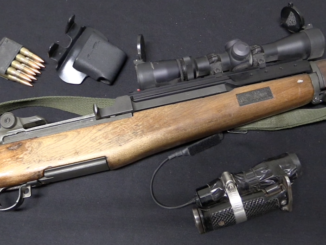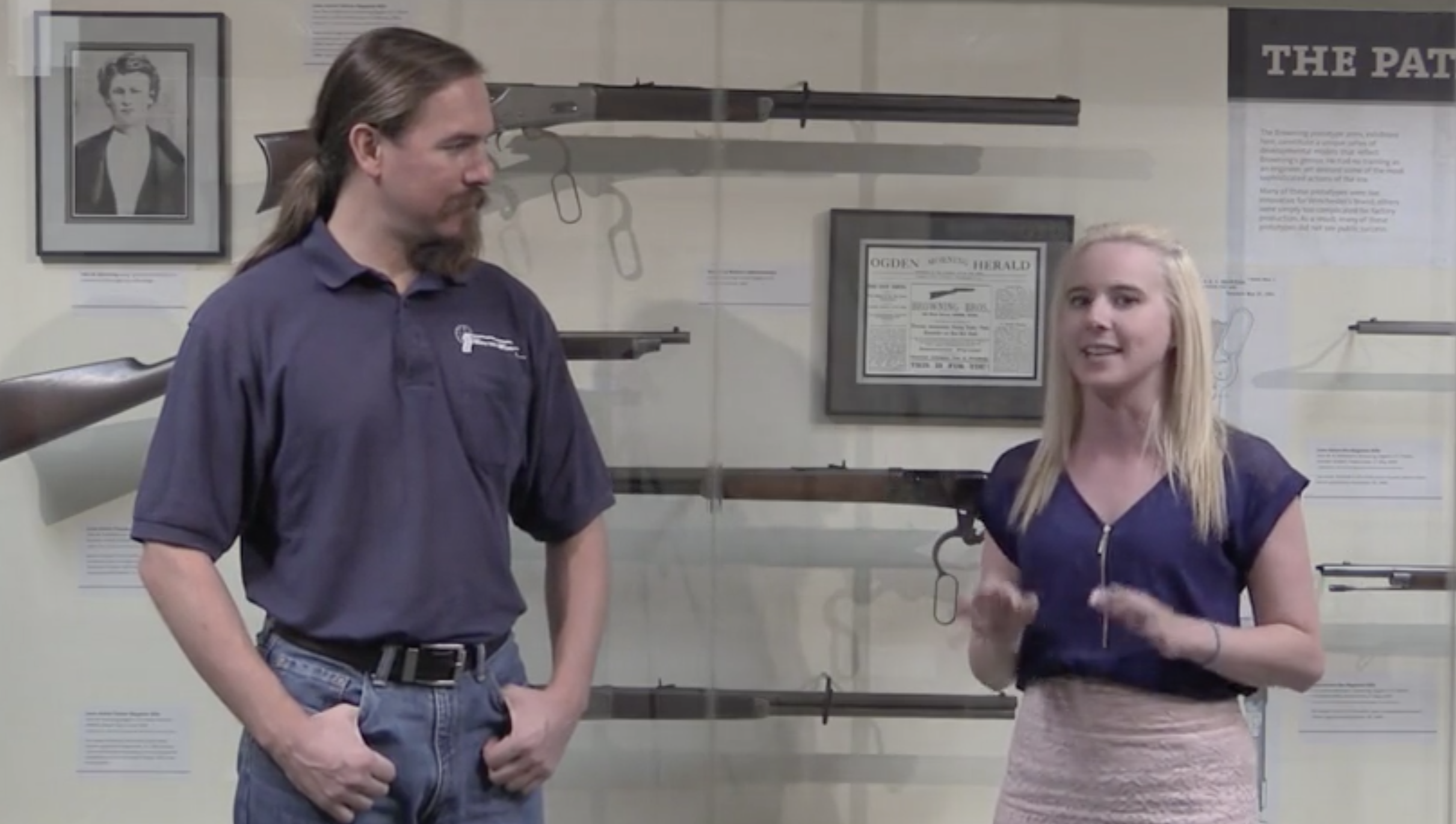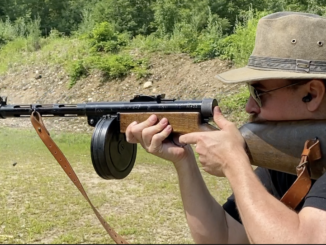When World War One began, German armies roared through Belgium, occupying all but a small corner of the nation. Belgium still had an army to defend that last bit of territory, but it no longer had any of its manufacturing base. The Belgian State Arsenal was evacuated, but took several years to reorganize and restate in Birmingham, England. In the meantime, Belgium was in serious need of rifles!
The United States was not yet in the war, and American companies were more than happy to make arms by the hundreds of thousands for the European forces. Belgium didn’t offer very good terms in its search for an American rifle maker, but found the Hopkins & Allen company at a moment when H&A had lost a major contract and desperately needed something to replace it. And so Hopkins & Allen signed a contract in August 1915 to make 140,000 rifles and 10,000 carbines. In their rush to sign a contract however, Hopkins & Allen didn’t consider what they were agreeing to. The low price of $27/rifle without any down payment led to the company’s bankruptcy in 1917 by the time barely 12,000 rifles had been delivered. It went into receivership, and the whole company was sold for $65,000 to Marlin-Rockwell.
Marlin had enough cashflow from other contracts (including the BAR and aircraft machine guns) to finish the Belgium contract, although the final deliveries did not occur until October 1918, as the war was nearly ended. These delays also meant that what had originally been contracted as Model 1889 carbines were actually manufactured to the improved 1889/16 pattern.
Belgium would rework its small arms in the 1930s, and the vast majority of Model 1889 Mausers were rebuilt as 89/36 carbines, which included scrubbing their original receiver markings. Intact Work War 1 pattern Hopkins & Allen rifles like this one are very rare today. Many thanks to Mike Carrick of Arms Heritage Magazine for providing me access to film this example!




The color of the finish on the stock appears to be identical to my 1903 Springfield, made by Remington in 1942. Interesting.
Truly a F.W.and very interesting history!
“When World War One began, German armies roared through Belgium, occupying all but a small corner of the nation.(…)”
Interestingly this also displaced Dieudonné Saive (would be designer of FN FAL) which become machinist for Vickers https://guns.fandom.com/wiki/Dieudonn%C3%A9_Saive
“(…)company’s bankruptcy in 1917(…)”
Wait… so they did go broke with war raging on in Europe and not only there, so where there is certainly high demand and many customers willing to pay to get fire-arms?
If yes, this looks similar to Brewster Aeronautical Corporation which did sell combat aeroplanes and managed to go broke in 1944.
Well, Brewster Aeronautical Corporation was a case of a subcontractor getting too big for its boots. The executives in Brewster had this nasty tendency to cheap out a lot, and put forward designs that just barely flew. The F2A Buffalo is one of the marginally better designs, considering how bad Brewster handled its production (the rather un-trained workers found themselves going without pay for weeks, and would retaliate by sabotaging their work, by going on strike, or by attempting to kill their bosses). Things came to a nasty blow-over when a Brewster-produced version of the F4U Corsair literally disintegrated midflight. The pilot managed to bail out, and purportedly said upon landing: “We want our money back!” I can imagine that a shore party of angry sailors and officers stormed Brewster’s headquarters and held up the board of directors at bayonet point.
If only things worked that way.
Because start-up costs on a new production contract are high. That’s why the down payment was needed in advance. Whatever resources Hopkins & Allen needed to proceed would have been scarce and expensive because all the other companies were ahead of it on their own foreign contracts.
Yes, a lot of companies are destroyed by a promising new product when they lack the capacity to actually fill the demand.
Actually 18 months from signing contract to beginning of production is pretty darn good. As Norman Friedman points out in “US Small Combatants” while mass production can achieve excellent results once it is up and running, it takes a long and involved process to set up the production line. Ford was going to mass produce subchasers, and his “Eagle Boats” were generally termed a failure from the production standpoint
“The original expectation, set out in a contract between Ford and the Navy on 1 March 1918, was for delivery of 100 ships: “one by mid-July, ten by mid-August, twenty by mid-September, and twenty-five each month thereafter,” or approximately one new Eagle boat completed each working day of the month. The first seven boats were not completed until the end of 1918, and succeeding boats were plagued by issues such as leaky fuel oil compartments. This state of affairs continued, even though the labor force reached 4,380 by July and later peaked at 8,000. The chief reasons were Ford’s excessive initial optimism and the inexperience of labor and supervisory personnel in shipbuilding. Upon the signing of the Armistice in November 1918, the number under contract, previously raised from 100 to 112, was cut to 60. Of these, seven were commissioned in 1918, and the remaining 53 were commissioned in 1919.
“However, historian David Hounshell states that “the Eagle boat venture cannot be considered successful by the standards of the war era or the present,” and today serves as a case study in the history of technology to illustrate the difficulty in transferring knowledge and techniques between superficially similar, but fundamentally different, fields of endeavor.”
Interestingly, PE-56 was sunk by a U-Boat in 1945, the next to last USN casualty in the Atlantic WAr. https://en.wikipedia.org/wiki/USS_Eagle_56
Mass production of anything is never as easy as it looks to people who don’t actually manufacture things. You can hand-wave all sorts of things when you’re writing a book, making a movie, or producing a play, but when it comes time to actually make something physical…? The process gets really, really messy.
Hopkins and Allen’s executives probably failed to really pay attention to implications of the war, when it came to things like whether or not they’d be able to source materials and find employees. As such, well… That’s why we have bankruptcies, so that inept management can be superseded and removed, freeing up resources for actual effective managers to take those resources over.
Although, if they’d have had the WWII War Production Board around to allocate all that, Hopkins & Allen might have come through intact. It’s too bad that such a storied manufacturer went to the boards due to inept management, but there ya go.
I applaud the commitment of the Belgian government to equipping their forces with the national rifle, even though only a small sliver of Belgium was not in German hands. I imagine the British or French may have been willing to offer the remnants of the Belgian army rifles, but only Belgian Mausers it would seem were adequate.
I can’t help but think that someone did not think this one through properly.
JohnK, This was at a time when both the UK and France were buying Arisakas because it didn’t have enough SMLE’s. The US was building P14’s for Britain and sold such oddities as 4500 Remington Rolling Blocks to the Royal Navy. Belgium had the tools, jogs and fuxtures and a trained work force in Britain. It would have taken longer to retrain the workers and convert the tools to build the SMLE than to build the Belgian Mauser
Incidently, the barrel shroud was notorious for trapping moisture, causing rifles to be condemned to excessive rust on the barrels
A fair point. Nonetheless, if the Belgians needed rifles, it might have made sense to take whatever the market could provide, rather than insist on their own bespoke Mauser. The facts would seem to support this.
wonder what a estimate value would be , for a h&a stamped 1889 carbine ? have searched almost everywhere and havent seen any lately . a friend has one . neat piece of our history !